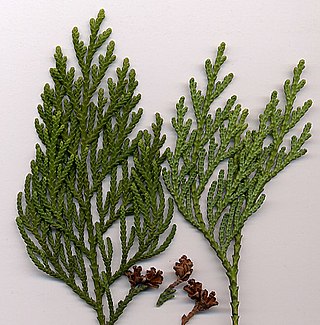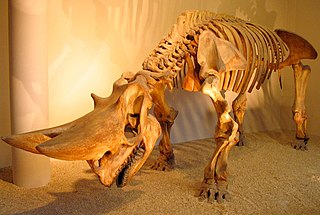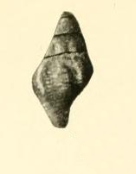
Thuja is a genus of coniferous tree or shrub in the Cupressaceae. There are five species in the genus, two native to North America and three native to eastern Asia. The genus is monophyletic and sister to Thujopsis. Members are commonly known as arborvitaes, thujas or cedars.

Sunnyodon is a genus of tiny, extinct mammal, probably of the Lower Cretaceous. Found in what is now southern England and Denmark, it was a relatively early member of the extinct order of Multituberculata. It is part of the suborder Plagiaulacida and family Paulchoffatiidae.
Paracimexomys is a genus of extinct mammals in the extinct Multituberculata order. Paracimexomys lived during the Cretaceous period. The few fossils remains come from North America. Some Romanian fossils were also tentatively assigned to this genus, though that classification now seems doubtful.
Cedaromys is an extinct mammal which lived during the Upper Cretaceous, at the same time as many dinosaurs. It was a member of the also extinct order of Multituberculata. It's within the suborder of Cimolodonta, and a possible member of the Paracimexomys group.
Cernaysia is an extinct genus of mammal from the Paleocene of France and the United States. It existed in the age immediately following the extinction of the last dinosaurs. This animal was a member of the extinct order Multituberculata within the suborder Cimolodonta and family Neoplagiaulacidae.
Mesodma is an extinct genus of mammal, a member of the extinct order Multituberculata within the suborder Cimolodonta, family Neoplagiaulacidae. It lived during the upper Cretaceous and Paleocene Periods of what is now North America. The earliest definitive record is from the late Santonian stage strata of the Straight Cliffs Formation. A single premolar tooth from the lower Cenomanian stage strata of the Cedar Mountain Formation has been tentatively assigned to this genus based on its similarity, but its describers noted that it is unlikely that Mesodma lived during that time.
Mimetodon is a small mammal from the Paleocene of North America and perhaps Europe. It was a member of the extinct order Multituberculata within the suborder Cimolodonta and family Neoplagiaulacidae.

Thuja plicata is a large evergreen coniferous tree in the family Cupressaceae, native to the Pacific Northwest of North America. Its common name is western redcedar in the U.S. or western red cedar in the UK, and it is also called pacific red cedar, giant arborvitae, western arborvitae, just cedar, giant cedar, or shinglewood. It is not a true cedar of the genus Cedrus. T. plicata is the largest species in the genus Thuja, growing up to 70 metres (230 ft) tall and 7 m (23 ft) in diameter. It mostly grows in areas that experience a mild climate with plentiful rainfall, although it is sometimes present in drier areas on sites where water is available year-round, such as wet valley bottoms and mountain streamsides. The species is shade-tolerant and able to establish in forest understories and is thus considered a climax species. It is a very long-lived tree, with some specimens reaching ages of well over 1,000 years.

Arsinoitherium is an extinct genus of paenungulate mammals belonging to the extinct order Embrithopoda. It is related to elephants, sirenians, and hyraxes. Arsinoitheres were superficially rhinoceros-like herbivores that lived during the Late Eocene and the Early Oligocene of North Africa from 36 to 30 million years ago, in areas of tropical rainforest and at the margin of mangrove swamps. A species described in 2004, A. giganteum, lived in Ethiopia about 27 million years ago.
Barawertornis tedfordi was a dromornithid (mihirung), a large flightless fowl hailing from Late Oligocene to Early Miocene. The only species in the genus Barawertornis, its fossil remains are found in strata of the Riversleigh deposits located at two sites in Northwestern Queensland, Australia.

Patagopteryx is an extinct monotypic genus of patagopterygiforms that lived during the Late Cretaceous, around 80 mya, in what is now the Sierra Barrosa in northwestern Patagonia, Argentina. About the size of a chicken, it is the earliest known unequivocal example of secondary flightlessness: its skeleton shows clear indications that the ancestors of Patagopteryx were flying birds.
Eogavialis is an extinct genus of eusuchian crocodylomorph, usually regarded as a gavialoid crocodylian. It superficially resembles Tomistoma schlegelii, the extant false gharial, and consequently material from the genus was originally referred to Tomistoma. Indeed, it was not until 1982 that the name Eogavialis was constructed after it was realised that the specimens were from a more basal form.

Elaeocyma is a genus of sea snails in the family Drilliidae.

Plicatula is a genus of saltwater clams, marine bivalve molluscs, known commonly as kitten's paws or kittenpaws in the family Plicatulidae.

Parietobalaena is an extinct genus of baleen whale, belonging to the family Pelocetidae. Fossils are found in Miocene-aged marine strata in North America, Europe, Australia, and Japan, including the Temblor and Itahashi formations. Based on previous estimates of juvenile specimens, Tsai (2017) suggested a body size of 12-15 m for P. yamaokai, akin to that of the gray whale.

Megalochelys is an extinct genus of tortoises that lived from the Miocene to Pleistocene. They are noted for their giant size, which is among the largest of any known testudine, with a maximum carapace length over 2 m (6.5 ft) in M. atlas. During the dry glacial periods it ranged from western India and Pakistan to as far east as Sulawesi and Timor in Indonesia, though the island specimens likely represent distinct species.
Elaeocyma citharella is an extinct species of sea snail, a marine gastropod mollusk in the family Drilliidae.
Elaeocyma drilliaeformis is an extinct species of sea snail, a marine gastropod mollusk in the family Drilliidae.
Simblaspis is an extinct monospecific genus of arthrodire placoderm fish of the Early Devonian period. The type species Aleosteus eganensis was described in 1958, and was found in Pragian strata of the Qasr Limestone in Saudi Arabia.

Turris plicata is an extinct species of sea snail, a marine gastropod mollusk in the family Turridae, the turrids.










